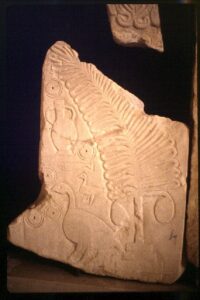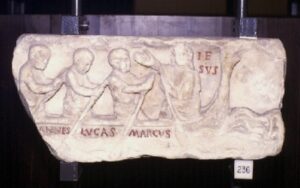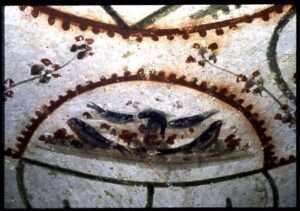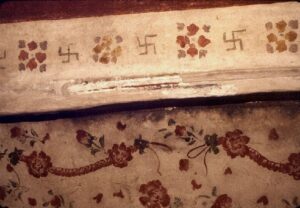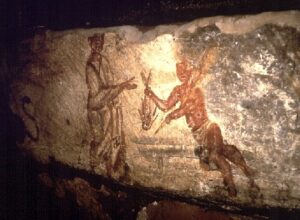Fauna: Fish. Excerpt from: Estelle Shohet Brettman, Vaults of Memory: The Roman Jewish Catacombs and their Context in the Ancient Mediterranean World, with Amy K. Hirschfeld, Florence Wolsky, & Jessica Dello Russo. Boston: International Catacomb Society, 1991-2017 (rev. 2024).
Waterfowl and fish were pictured in the Jewish and Christian catacombs of Rome. Their association was a long one in funerary contexts as in other depictions of paradise; it figures in ancient Egyptian and Etruscan tomb paintings and furnishings. Both were represented as food offerings to the deceased in Egyptian burials, and in Greek graves as early as the first part of the first millennium B.C.E.; one example of Geometric art shows a tier of dead ducks bound to a bier, and, in another image, a child bears a fish to his deceased father's mouth.[1] Possibly the duck like the fish represented still another metaphor for the soul, or, in any event, nourishment for the deceased in an expected hereafter.
Fig. 1. Adjoining lunettes outlined by a spray of roses enclose either ducks or fish flanking a stump-like object. Detail of vault painting of a cubiculum in the catacombs of Vigna Randanini, Rome.
Fig. 2. A marble fragment from Palazzolo Acreide (ancient Akrai), Sicily, presents a panoply of familiar symbols: a large duck, a small fish, a dove, an amphora, and a number of concentric circles sometimes described as depictions of unleavened bread", shaded by a swaying palm tree with pendant fruit. Frey suggests that a menorah may have been carved on the missing left section of the stone.[2] In 1978, the author observed a menorah graffito on a rock in a Greek and Byzantine cemetery in the same region.
Fig. 3. Terracotta larnax decorated with fish and ducks amidst papyrus plants and stylized rosettes or astral-like objects. 1400-1350 B.C.E. From Vasilika Anogeia, Crete.
Fig. 4. A papyrus thicket, the river and its ambiance teem with aquatic life--plant, fish, fowl, and animal. Menna, the manager of the estates under Pharaoh Tuthmosis IV and superintendent of agriculture, fishes with a spear and hunts with a boomerang, in two facing images, simultaneously - in typical Egyptian conceptualizing fashion. Other members of the household assist, holding or plucking the symbolic blue lotus in an idealized version of the afterlife. Wall painting from the tomb Q of Menna (No. 69) at Thebes. New Kingdom, Late Eighteenth Dynasty.
An excerpt from an earlier Coffin Text describes the departed enjoying such amenities: "Thou goest around the countries with Re s[Ra]: "he lets thee see the pleasant places… thou pluckest marsh-flowers… lilies and lotus-flowers. The bird-pools come to thee by thousands, lying in thy path~ when thou hast hurled thy boomerang against them, it is a thousand that fall at the sound thereof…Thou sailest in the Lily-lake.”[3]
Isolated in a "mountain of water", the two fish that Menna is in the process of spearing, the inty -- also known as bolti or tilapia nilotica -- was believed to be important ritually for the rebirth of the deceased, and is related to the fish that fed the multitude (John 6:9-11, Mt. 4:13-21; Mk. 6:32-44; Lk. 9:10-17). Their vertical position appears to have had a special meaning, since there are later parallels -- for example in such curious depictions as those painted under a horse on the fragment of a Geometric vase (often marking burials) from Tiryns' and the representation of an upright single fish on the skirt of the "mistress of the animals".[4]
Fig. 5. Under a star, the enthroned, Mesopotamian creator-god of the fresh-water ocean (abzu in transliterated Sumerian) Enki/Ea, of the flowing waters teeming with fish, grasps flowing vases with fish swimming upstream. This god of wisdom sits vis-a-vis his two-faced minister Isimud (circa 2200 B.C.E.).[6] The motif of the fish has been used, ornamentally or in a cultic sense, as early as the late Paleolithic period. The feats of the Sumerian Enki, (Babylonian Ea) the god of water and fertility: "He cal[led the marshland), placed in it carp (and)… -fish, He cal(led the canebrake], placed in it…-reeds (and) green reeds… Him who[se net] no fish escapes … (a god) who loves fish, Enki placed in charge of them”- bring to mind the description of the wall painting in the catacomb of the Via Appia Pignatelli in Rome, presumed by some scholars to be Jewish.[5]
Fig. 6. Fishers of Men. In early Christian iconography, souls symbolized by fish were fed, renewed, and purified by the nurturing waters of baptism; and, thus, by analogy, Jesus made his disciples "fishers of men". Jesus expounds to Luke, Mark and John as they row across the waters of the Sea of Galilee. De Rossi believed that Simon Peter was represented on the missing portion of the fragment that was perhaps from the lid of a sarcophagus.[7] Marble relief now in the Vatican Museums. Fourth century CE.
"And Jesus said unto them [Simon and Andrew], Come ye after me, and I will make you to become fishers of men (Mark 1:17; Matt.4:19). Upon catching "a great multitude of fishes" in their nets by following the instructions of Jesus, Simon Peter was told by Jesus: "Fear not; from henceforth thou shalt catch men" (Luke 5:4-6, 10). Clement of Alexandria referred to Jesus as a "fisher of men that are being saved”.[8] Tertullian wrote "But we little fish…are born in the water, nor are we saved in any other way than by remaining in the water.”[9] This recalls the faithful who, like fish, were nurtured by the saving, living waters of the Torah.
Fig. 7. Sustenance for the Faithful. Jesus (or possibly a priest) attired in dalmatic (long-sleeved robe) and sandals, bears a crux hasta or staff-like cross. In a scene with connotations of salvation, rosettes stud the field above Jesus, the cross, and the two symbolic fish which swim vertically on each side. The short stylized curls crowning his head date this piece to the first half of the fifth century. Terra-cotta paten probably from North Africa.[10] "And Jesus said unto them, I am the bread of life: he that cometh to me shall never hunger; and he that believeth on me shall never thirst" (John 6:35) reminiscent of the psalmist's "For with thee [the Lord] is the fountain of life" (Ps. 36:9). Fish flank a palm branch or palm tree on a lamp from Palestine, perhaps alluding again to the theme of the tree of life, symbolizing a beneficent god nurturing the faithful much like the lamp on which doves are substituted for the fish.[11]
When Jesus appeared after his resurrection, he taught his disciples how to catch fish. His feeding of his followers was prologue to Peter's commission from Jesus to ..feed his sheep" (John 21:1, 6-8, 17). The providing of the disciples with fish and bread at this breakfast could have been an allusion to the establishment of the Eucharist (John 21:9, 13).
Fig. 8. Drawing or photo. A pair of fish facing in opposite directions, like the zodiac sign Pisces, feast on grapes and a round object, an apparent wafer, suggesting the eucharistic ritual. Tombstone of Mercurius Vibius in the catacombs of S. Callisto, Rome.
Fig. 9. Among other evidences of nature's bounty set into the border of the mosaic floor of the early sixth-century Beth Alpha synagogue in ancient Israel, lozenges enclose inlays of fish, grapes and a container presumably filled with bread.
Fig. 10. A fish is juxtaposed in back of a basket brimming with eucharistic loaves and wine. Wall painting, cubiculum y, Crypt of Lucina, catacombs of S. Callisto, Rome.
Fig. 11. Fish Grouping with Messianic Implications: Supporting a limp, apparently dead fish is a central object that might be a short column or pillar, a symbol with ritual connotations as early as the Bronze Age. The attitude of the fish hovering around this enigmatic image is similar to that of the fish bearing the wine and bread of the Eucharist in the catacombs of S. Callisto. Rome. Ichthys (ixous) is the Greek word for fish and an acronym for Jesus Christ, Son of God. Christos (xpiotos) is the Greek word for the "anointed one”, which translates as "Messiah" from the Aramaic/Hebrew, and so this fish could have messianic connotations in the iconography of the Christian catacombs.
Alternatively, the summarily rendered, stump-like object might allude to the sustaining fountain of the deep (evoking pictorially "the mountain of water" painted in the tomb of Menna) over which dwells that mythical creature of Jewish lore, the Leviathan. The large fish, possibly symbolizing the Leviathan, in the mosaic floor of a synagogue at Hammam Lif, were depicted not far above the krater with the fountain. In addition to arching over these scenes, roses also bespatter the field and the ground of the vignettes in which fish are depicted. Vault painting. Cubiculum II, catacombs of Vigna Randanini, Rome.
Fig. 12. Two fish flank the base of a chalice and one floats within. A fourth-century purportedly Christian floor mosaic. Domus dei Pesci, Ostia Antica. In a comparable image, five fish are impressed crudely within the body of an amphora on the base of a lamp from Jerash, Palestine. Represented on the top of the lamp are peacocks and fish near solar crosses with circles.[12] The cross, like the swastika (a solar symbol) and the rosette, appeared often in art of the Geometric period in Greece. Goodenough opines that this lamp is talismanic, and that there is a possibility that it is Jewish. He uses the resemblance of the vessel to that on the relief from Akrai in Sicily as an argument. But that hardly seems like substantial evidence.
Fig. 13. A carved table-like tombstone (tomba a mensa) from Timgad (today northeast Algeria) depicts fish, a utensil, a ladle with a hole in the bowl, probably for pouring libations or offerings such as water or wine, amid circular objects (one of which could represent bread) and time-honored rosettes--a panoply of themes which might have inspired such figurations in the catacombs and other Roman contemporary Jewish and Christian sites. On a second to third-century Roman lamp from Jerusalem a pair of fish, impressed on each side of the pour-hole, seemingly are about to gulp down two heavily ornamented concentric circles which because of the linear demarcations between the central boss and the outer circle could represent those symbols of regeneration, solar objects or rosettes. According to Miriam Schloessinger. these symbols are intended to suggest the fertility goddess Atargatis, concerned with wheat and the fruits of the earth, in her role of the fish-goddess and the "Supreme Goddess of light”.[13] Two fish swimming towards concentric ovals, perhaps alluding to the "female procreative element” (or symbolizing bread?), and if so, they could allude to a fertility goddess such as Atagartis, decorate a second to third-century lamp from Jerusalem.[14]
Fig. 14. A fish is carved on an offering table amidst other symbols, such as round objects, one of which has rays emanating from it like the vitalizing sun. Impression of a Phoenician cylinder seal from Sarepta, Lebanon.[15] Fish was offered daily to Atargatis, and her devotees may have achieved communion with her in the celebrations of the Syrian mysteries.[16] Indications that fish along with roosters were favored offerings to deities of the netherworld and to the deceased in Roman times are supported by the representation on "an early Roman lamp" of a fish and two roosters on an altar.[17] And the "sun, moon, and possibly a star" shine down upon a fish apparently arising from fecund waters between two birds, seemingly friendly roosters--age-old symbols of virility, carved on a fifth-century Achaemenid stamp-seal from Nippur.[18] Goodenough speculates that the concept of the sacramental fish might have been transmitted from the Near East to Italy, given such testimony as the holy meal pictured in the Sabazian hypogeum on the Via Appia.[19] The fact that at times the belief could have travelled via Punic-influenced North Africa, might be attested to by the banqueting scene from the Vergilius Romanus.[20] Leaning on the customary bolster in this vignette, Dido, Aeneas and his Trojan companion (both males wear Phrygian caps), all nimbed, partake of fish and loaves while attendants bring wine.
Fig. 15. Drawing or photo. Eight fish, probably representing the deceased, surround a rosette upon which they nibble. Third to fourth century stone funerary relief from Ghirza, Tripolitania.[21] On the central discus of a Byzantine lamp from Carthage, the rosette becomes the focal point below a fish lying across the channel. The fish and the palm branches, on the rim, enclosing the motifs make the lamp Christian according to Miriam Schloessinger--not entirely convincing reasoning, since both motifs are also present in Jewish contexts.[22]
Fig. 16. In its more ancient Egyptian counterpart, a painting on an Early Pre-dynastic Egyptian bowl, a stylized rosette decorates the center around which three geometrized hippopotami, also aquatic creatures, are seen swimming in a zigzag design symbolizing water. The divinity who was the protectress of Egyptian women in childbirth took the form of a pregnant hippopotamus. Circa fourth millennium B.C.E. Seen repeatedly in the Roman catacombs, the rosette, like the lotus, was presumed to possess renewal powers in Mediterranean cultures from earliest times. On a Greek fibula of the Geometric period, swastikas and rosettes are incised near the waterfowl interspersed among fish.[23] Painted on a Mesopotamian bowl of the fifth millennium B.C.E., the swastika replaces the rosette as the focal point which is encircled by the same aquatic creatures.[24]
Fig. 17. Swastikas are depicted next to rosettes or alone in Roman burials. Painted arch over an arcosolium. The mausoleum of Clodius Hermes, under the catacomb of S. Sebastiano, Rome.
Roses and rosettes are well-represented in the Jewish catacombs of Rome as well as in other cemeterial contexts; a crisply defined example takes pride-of-place above a tomb door of hall E, in catacomb 13 at Beth She'arim.[25]

Fig. 18. DAPICS n. 2087. Fig. 18. Swastikas painted near an oval figure above a loculus in the Christian catacomb of the Giordani, Rome.

Fig. 19. A swastika is painted near an ivy leaf on the Jewish epitaph of Pancharios in the Villa Torlonia catacombs.[26]. DAPICS n. 2924.
Fig. 20. Four of these species, three bearing lotus buds in their mouths, are shown circling around a minuscule square pool from which grow six more of the diurnally renewed lotus buds. Because the spawning habits of this fish, like the flowering process of the blue lotus (associated with the rebirth from primordial waters of the sun-god as a child every dawn), appeared to make them self-generating and regenerating respectively, the inty fish and the lotus became symbols for rebirth in the hereafter. In one subspecies the eggs are hatched from their mouths. The device impressed on a second-third century lamp from Jerusalem, showing one of a pair of fish (perhaps of this species), holding two small circular objects in its mouth could be interpreted this way.[28] The tilapia was also linked with the sun-god, since it assisted in drawing his celestial bark across the heavens in its daily journey. Faience Bowl. Eighteenth Dynasty.[29]
Appropriately, the deceased pharaoh had to cross the "Lily-Lake" along the eastern horizon in order to reach the realm of the sun-god where the sun-god was born every day.[30] The inty or tilapia fish was of major importance for the renewal of life. The pair of tilapia fish as seen in the "mountain of water" in the painting from the tomb of Menna could allude to the penultimate stage in a transmigration of the soul, born anew from primordial waters: one of the pair symbolizing life on earth now past as reflected in the deceased Osiris who had been resurrected to become king of the dead, and the other offering hope for a future which would be eternal like that of the sun- god.[31]
It is also recorded in "texts" that perhaps the reanimation could be effected by the meeting of the souls of the divinities, Osiris and Ra, the union believed to breathe life again into the fish and thus the defunct, at the sacred city of Mendes. At this Delta way-station, the third step in the transformation on the journey to rebirth, was consummated.[32] It seems pertinent that this fish, still savored today in the Galilee, is thought to be the species that swarmed into the nets of Simon Peter and Andrew who would become "fishers of men."
Also relevant was the relationship of this fish with the nurturing cow-goddess Hathor who, as the goddess of the West, the residence of the deceased, assisted in revitalizing processes. An image of a head resembling that of Hathor is carved between the graffito of a menorah and the name of the deceased, Socrates (COKPATOYC), on the lintel of hall C in catacomb 19 at Beth She'arim.[33] Thus two images of hope, from two diverse cultures, one iconic and one aniconic--not a rare phenomenon in the Roman catacombs either-- are juxtaposed on this tomb. As noted above, the Syrian Artemis, Atagartis too was associated with fish, and like her Egyptian counter-part Hat-mehit, the fish-goddess of Mendes (see above) was shown with fish about her head. And not to overlook a male counterpart, the Hittite sun-god who arises from the sea is described as having a "fish on his head.”[34]
The fact that the bowls with these motifs have been found mainly in tombs reinforces the significance of these themes in religious funerary beliefs. A mummy in the shape of a monumental fish presided over by Anubis, the jackal-headed embalming god of the dead, was depicted in a Theban tomb which could be dated to 1000 B.C.E. Painted in a Hellenistic tomb at Gamhoud, Egypt. And staring up at the sacred oxyrynchus fish suspended above him -- here substituting for the customary soul-bird, is a mummy about to make the journey into the next world.[35]
Fig. 21. Magical properties were long imputed to the fish and its organs, and the story of Tobit and the angel (Tobit 6:6-8) has been illustrated several times in the Christian catacombs. Tobias holds the healing, apotropaic fish in a painting from the catacomb of Trasone where there are several representations. There is also a much-ruined depiction in the new catacomb on the Via Latina and one no longer extant in the catacombs of Domitilla, Rome.[36]
In still other related roles, fish appear to have had amuletic qualities as early as the twenty-seventh century B.C.E. in the Royal Cemetery of Ur where they were found in the form of lapis lazuli and gold pendants, and have also been carved on late fourth to early third millennium cylinder seals.[37] Representations of priests, or healers garbed as fish appear in Mesopotamian art in the first millennium B.C.E.
Fig. 22. In the guise of a fish a ministrant grasps a situla or sacred bucket in his right hand. Side of a Nee-Babylonian chalcedony cone-shaped gem. Circa 625 B.C.E.[38]
In concluding this section--the fish has assumed many roles in early belief such as: warding off evil, curing ills, providing sacramental and saving food related to divinity, and in this way alluding to eternal life and even symbolizing the faithful devotees in Judaism and Christianity as well as the deceased in other cults. Like the dove, the fish often symbolized the soul or was associated with it in ancient belief. Hence the concept evolves that the rites performed to ensure survival in this life and renewal in the hereafter are not subject to the whims of fashion but continue through the ages albeit modified and adapted to the needs of the practicing religion.
[1] From E. Vermeule, Aspects of Death in Early Greek Art and Poetry (Berkeley, CA: University of California Press, 1979), pp. 17-18 and n. 32; also R. Tolle, "Figurliche bemalte Fragmente der geometrischen Zeit vom Kerameikos, Archaoligischer Anzeiger (1963), p. 662, fig. 20, and J. Boardman, "Attic Geometric vase scenes, Old and New," Journal of Hellenic Studies 86 (1966), lf.18.
[2] J-B. Frey, Corpus Inscriptionum Iudaicarum 1, n. 653 a.
[3] Breasted, Ancient Egypt, p. 279.
[4] H. Schliemann, Tiryns, (New York: Charles Scribner's Sons, 1885) p. 99, no. 20.
[5] S. N. Kramer, The Sumerians (Chicago: University of Chicago Press, 1963), p. 179 and see fig. 59.
[6] E. Porada and B. Buchanun, Corpus of Ancient Near Eastern Seals in North American Collections I: The Collection of the Pierpont Morgan Library (Washington D.C.: Pierpont Morgan Library, 1948), no. 204.
[7] This information like the date was conveyed by Dr. Walter Persegati, Secretary General and Treasurer of the Vatican Museums in a telephone conversation.
[8] Clement of Alexandria, "Hymn to Christ, the Savior" III, chap.12, in Paedagogus.
[9] Tertullian, De baptismo I, 2.
[10] G. Jacopi, L'antro di Tiberio e il Museo Archeologico Nazionale di Sperlonga (Rome: Istituto poligrafico dello Stato, Libreria dello Stato,Rome, 1970), p. 23, fig. 62.
[11] E. R. Goodenough, Jewish Symbols in the Greco Roman Period (New York: Pantheon, 1955), p. 8 and fig. 7.
[12] Goodenough, v. 3, fig. 376 and v. 5, p. 9.
[13] Miriam S. Schloessinger, "Five Lamps with Fish Reliefs from Israel and Other Mediterranean Countries," Israel Exploration Journal I (1950/1), pp. 91-92.
[14] Schloessinger, Five Lamps, pp. 87-88.
[15] J. B. Pritchard, Recovering Sarepta, a Phoenician City: Excavations at Sarafand, Lebanon, 1969–74 (Princeton, NJ: Princeton University Press, 1978), fig. 90.
[16] Goodenough, Jewish Symbols, v. 8, fig. 17.
[17] Schloessinger, Five Lamps, p. 85.
[18] Goodenough, Jewish Symbols, v. 8, fig. 17.
[19] Eliza Swift Morss, The Tomb of Vincentius: A Study in Syncretism (an undergraduate thesis, Harvard and Radcliffe Colleges, 1986), p. 20-21.
[20] Aeneid, Cod. Vat. Lat. 3867, pl. VI. Late fifth century CE, from a fourth century prototype.
[21] J. M. C. Toynbee, Death and Burial in the Roman World (London: Thames & Hudson, 1971), pl. 65.
[22] Schloessinger, Five Lamps, p. 94.
[23] Dated to the eighth century B.C.E.: see Goodenough, Jewish Symbols, v. 5, fig. 64.
[24] Goodenough, v. 14, fig. 15.
[25] N. Avigad, Beth She`arim: Report on the Excavations During 1953-1958. Vol. 3, Catacombs 12-13 (New Brunswick, New Jersey: Rutgers University Press, 1976), pl. IX, 2. There are a number of other instances of rosettes also in these catacombs, as well as from other funerary sites in ancient Israel.
[26] Frey, n. 48, and H. W. Beyer and H. Lietzmann, Die jüdische Katakombe der Villa Torlonia in Rom (Berlin: Walter de Gruyter & Co, 1930), pl. 16.
[27] Goodenough, Jewish Symbols, v. 6.
[28] Goodenough, Jewish Symbols, v. 8, fig. 5.
[29] R. E. Freed, ed., Egypt's Golden Age: The Art of Living in the New Kingdom 1558-1085 B.C. (Boston: Museum of Fine Arts, Boston, 1982), catalogue nn. 138-140 and 353.
[30] Breasted, Ancient Egypt, p. 105.
[31] For further details on these beliefs, see Christiane Desroches-Noblecourt, "Poissons, Tabous et Transformations du Mort," Kemi vol. XIII (Paris, 1954), pp. 34-42.
[32] Desroches-Noblecourt, "Poissons, p. 37.
[33] Avigad, Beth She’arim, p. 81 and PL. XXVII.
[34] O. R. Gurney, The Hittites (Harmondsworth: Penguin, 1969), p. 139.
[35] Goodenough, Jewish Symbols, v. 5, 14.
[36] A. Ferrua, The Unknown Catacomb: A Unique Discovery of Early Christian Art, trans. I. Inglis (New Lanark, Scotland: Geddes and Grossett, Ltd., 1991), pl. XVIII, and J. Stevenson, The Catacombs: Life and Death in Early Christianity (Nashville: T. Nelson, 1978), p. 81, respectively.
[37] L. Wooley, Excavations at Ur: A Record of Twelve Years' Work (New York: Thomas Y. Crowell, 1965), p. 66.
[38] Cornelius C. Vermeule III, Boston Museum Bulletin, vol. LXVIII, No. 353, "Near Eastern, Greek, and Roman Gems" (1970), p. 201.

